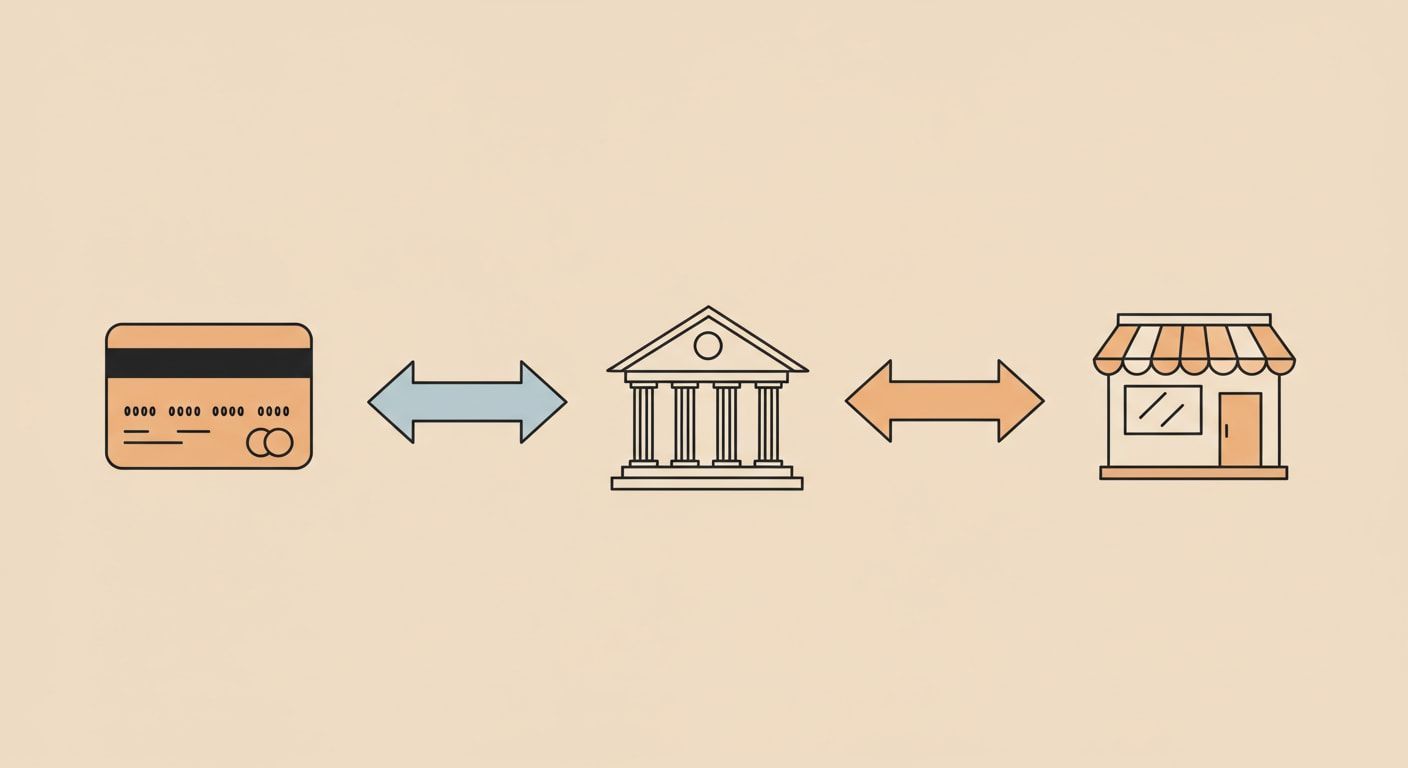How to Reduce Interchange Fees - 10 Strategies for 2025

Interchange fees are a huge chunk of your payment processing costs. While you cannot negotiate these types of fees, there are ways to optimize your payments and cut costs. However, most businesses fail to realize this and end up overpaying up to 40% on these credit card network charges.
At Momentum Growth Partners, our trusted payment processing consultants work directly with high-volume merchants, enterprises, and startups to identify hidden payment processing fees and renegotiate unfavorable terms with payment processors. In this blog, we will go over what interchange fees are and the 10 strategies you can explore to reduce your payment processing costs.
Let's get started!
Understanding Interchange Fees

When a customer pays via card, the merchant's bank (acquiring bank) pays a fee to the customer's bank (issuing bank) to complete the purchase. This payment processing cost is also referred to as an interchange fee. These are set by credit card companies like Visa, Mastercard, Discover, and American Express.
How do interchange fees work? A few steps are involved in processing a credit card transaction (in-store or online), and they include the following:
- Transaction initiation: A customer initiates the transaction by making a purchase. This could be a card-present and card-not-present (CNP) transaction.
- Transaction authorization: The payment terminal forwards the card and payment details to the merchant's bank before routing all of the information to the customer's card issuing bank for authorization.
- Transaction approval: The issuing bank receives the transaction details and must decide whether to process it. If it approves the payment, it will freeze the funds in the cardholder's account.
- Settlement: At the end of the day, the merchant's POS system bundles all transactions before sending them over to the acquiring bank for further processing. These transactions are categorized and sent to the respective card networks. They communicate with the issuing bank for the final fund transfer.
- Fund transfer: The funds move from the issuer bank to the card networks, eventually being deposited into the merchant's account. During this transfer, the merchant's bank keeps a certain percentage of the funds as service charges before transferring the rest.
How to Reduce Interchange Fees: 10 Strategies to Optimize Payments

Credit card processing fees can gradually eat away at your profit margins. For high-volume businesses, they can add up to hundreds and thousands of dollars. Fortunately, you can reduce fees through interchange optimization.
Want to learn how to lower interchange fees? Here are 10 effective strategies:
1. Check your Merchant Category Code (MCC)
Card networks set specific rates for different business types based on perceived risk and transaction characteristics. They provide each merchant with a unique Merchant Category Code (MCC) to determine the interchange rates that apply to their transactions.
It's important to check whether you're using the right MCC. Over the years, some businesses may expand into eCommerce, but they may still be carrying a brick-and-mortar code. This may lead to higher interchange fees that may be unnecessary.
A great way to optimize your payments is to start by checking your MCC. Request the code from your payment processor and verify it. If there are any issues, reach out to your processor for assistance.
2. Accept the Type of Card or Transaction with Lowest Rates
There are several factors that can affect interchange fees, including the card type and transaction method. For example, debit card transactions have lower interchange rates than credit card transactions, while basic cards cost less than corporate cards. Understanding these differences can help you minimize your transaction costs when accepting payments.
What many retailers don't know is that card-present transactions (EMV chip, tap-to-pay) qualify for the lowest rates. On the other hand, CNP transactions carry higher fraud risk and unnecessary fees.
If you want to accept card payments, make sure to strategize properly. Ensure all physical locations use EMV-compliant payment technology and encourage tap-to-pay when possible.
However, for e-commerce businesses, they should consider fraud prevention tools like 3-D Secure 2.0 to qualify for better rates.
3. Use Address Verification Services (AVS)
To combat fraud with card-not-present transactions, merchants should use Address Verification Services. Even partial AVS matches can provide better rates than no verification.
For credit card processing, it's important to enable AVS. However, improper implementation can lead to unnecessary downgrades. Merchants must work with their payment gateway to ensure proper capturing and transmission of AVS response codes.
4. Settle Transactions Daily
Late settlement of transactions can lead to higher fees, which is why it's important to settle payments within 24 to 48 hours. Also, credit card networks offer the lowest rates for prompt batching.
Businesses must automate their systems to batch all card transactions within 24 hours. Depending on the transactions processed, some merchants may need to consider multiple settlements every day.
5. Provide Level 2/3 Data
If a business sells products and services to other businesses or the government, it may enjoy greater savings with Level 2/3 data. What is it, and how can it impact your payment processing fees?
When making payments, the system provides basic information like merchant name, transaction amount, and date. This is applicable across all sorts of cards, including corporate and government cards.
That said, card networks provide lower rates on B2B and B2G transactions if the merchants provide additional information about the transaction. This is referred to as Level 2/3 data, and may include:
- Customer codes
- Sales tax amounts
- Tax indicators
- Line-item details like item descriptions, quantities, unit costs, and more
High-volume merchants can save up to 1% for processing card payments by capturing Level 2/3 data. To enjoy such savings, you should verify your payment gateway and POS systems while implementing workflows for better data collection.
6. Choose the Right Pricing Model
Interchange fees vary according to the pricing model you choose. There are several pricing models that merchants can opt for, and the most common ones include the following:
- Tiered pricing: Under this pricing model, there are three different buckets, and they are "qualified," "mid-qualified," and "non-qualified." Processors decide which transactions fall into which tier, often downgrading transactions that could qualify for lower interchange rates and pocketing the difference. This lack of transparency can lead to higher costs and even additional fees.
- Flat-rate pricing: Under this pricing model, processors charge a single percentage regardless of card type or transaction method. While simple, this rate includes massive markups and hidden fees, making it expensive for high-volume businesses whose average interchange is typically much lower. Don't forget to read our blog on "How Flat Fee Credit Card Processing Affects Profitability" to learn more.
- Interchange-plus pricing: Under this pricing model, processors charge the exact interchange fee plus a transparent, fixed fee processor markup. For different types of credit card payment processing, this is the best option to consider. Check out our comparison guide on “Tiered vs. Interchange-Plus Pricing: What's Best for You?” for further help.
7. Encourage Cash Transactions
While accepting credit card payments offers convenience for customers, it can affect your bottom line. To reduce payment processing costs, you can encourage cash transactions. These incur zero processing fees and can improve your cash flow situation.
However, discouraging card payments is not always practical. The lack of payment options can deter potential customers from making a purchase. That said, merchants can offer discounts to persuade buyers into buying a product or service.
8. Adding a Surcharge
Depending on your transaction volume, you may have to pay huge interchange fees every month. To reduce this financial burden, some merchants pass on these costs to the customer. They add a surcharge to the final amount before executing the transaction.
However, careful implementation is important. While adding a surcharge is legal in most US states, merchants must comply with specific requirements. Failure to do so may lead to trouble with the law.
9. Minimize Manually Keyed-in Transactions
Manually entering card numbers into your payment system can lead to higher interchange fees. This is due to the increased risk of fraud associated with manual transactions.
Merchants should streamline their business processes to minimize manual data entry. They can:
- Use secure virtual terminals for phone orders that auto-populate and validate data.
- Send secure payment links for invoicing rather than manually entering customer information.
- Equip mobile sales teams with EMV-compliant devices instead of relying on manual entry.
10. Audit Processing Statements Regularly
Whether you're looking to optimize interchange rates or negotiate lower assessment fees, you must know how to read and audit a processing statement. Most merchants have no clue how to do that, resulting in higher fees.
Fortunately, businesses can work with experienced payment processing consultants to audit their statements for optimization opportunities. They have deep industry knowledge and strong relationships with processors to ensure a better interchange fee rate.
Optimize Interchange Fees with Momentum Growth Partners Today!

Merchants have a lot of things to figure out. They need to actively manage operations while optimizing their payment ecosystem for greater savings. This requires knowledge and skills that they may not have. Fortunately, businesses can rely on us to optimize their interchange fee rates.
Over the years, Momentum Growth Partners has worked with many high-volume merchants and enterprises to reduce their payment processing costs. Our experienced payment processing consultants can help audit your statements, identify hidden costs and saving opportunities, and execute strategies for improved profit margins.
Call us at +1 (888) 682-8004 to schedule a consultation with an expert and take control of your payment ecosystem today!




